
MINERVA GAS INC.





5.1
5.2
5.3
5.4
5.5
5.6
6.1
6.2
6.3
6.4
6.5
7.1
7.2
7.3
7.4
7.5
Minerva Gas aims to demonstrate its commitment to sustainable development and environmental stewardship by publishing this inaugural report.
Our aim is to continuously improve our Environmental, Social, and Governance (ESG) performance. This report details our accomplishments and goals set out in this field. The purpose of this report is to assist our people, clients and various industry stakeholders understand the sustainability priorities, strategies, and initiatives of Minerva Gas.
We intend to communicate the identified environmental, social, and governance (ESG) impacts of our business in a comprehensive way, whilst at the same time maintaining transparency throughout.
This report was developed according to internationally recognized sustainability reporting standards. It describes critical aspects and data about our sustainability performance and represents a key milestone in our path towards sustainability.
Going forward, we intend to continuously monitor, and enhance the quality of our ESG disclosures, and sustainability performance.
Global Reporting Initiative (GRI)
Our report has been prepared in accordance with the GRI standards: Core option, which is widely seen as the global best practice for sustainability reporting.
Sustainability Accounting Standards Board (SASB)
We have also applied Marine Transportation reporting standard offered by the SASB to guide our disclosures on sector-specific ESG issues.
This Sustainability Report was published in November 2022.
The report consists of disclosures for the financial year ending 31 December 2021 (“FY2021”).
sustainability@minervagas.com

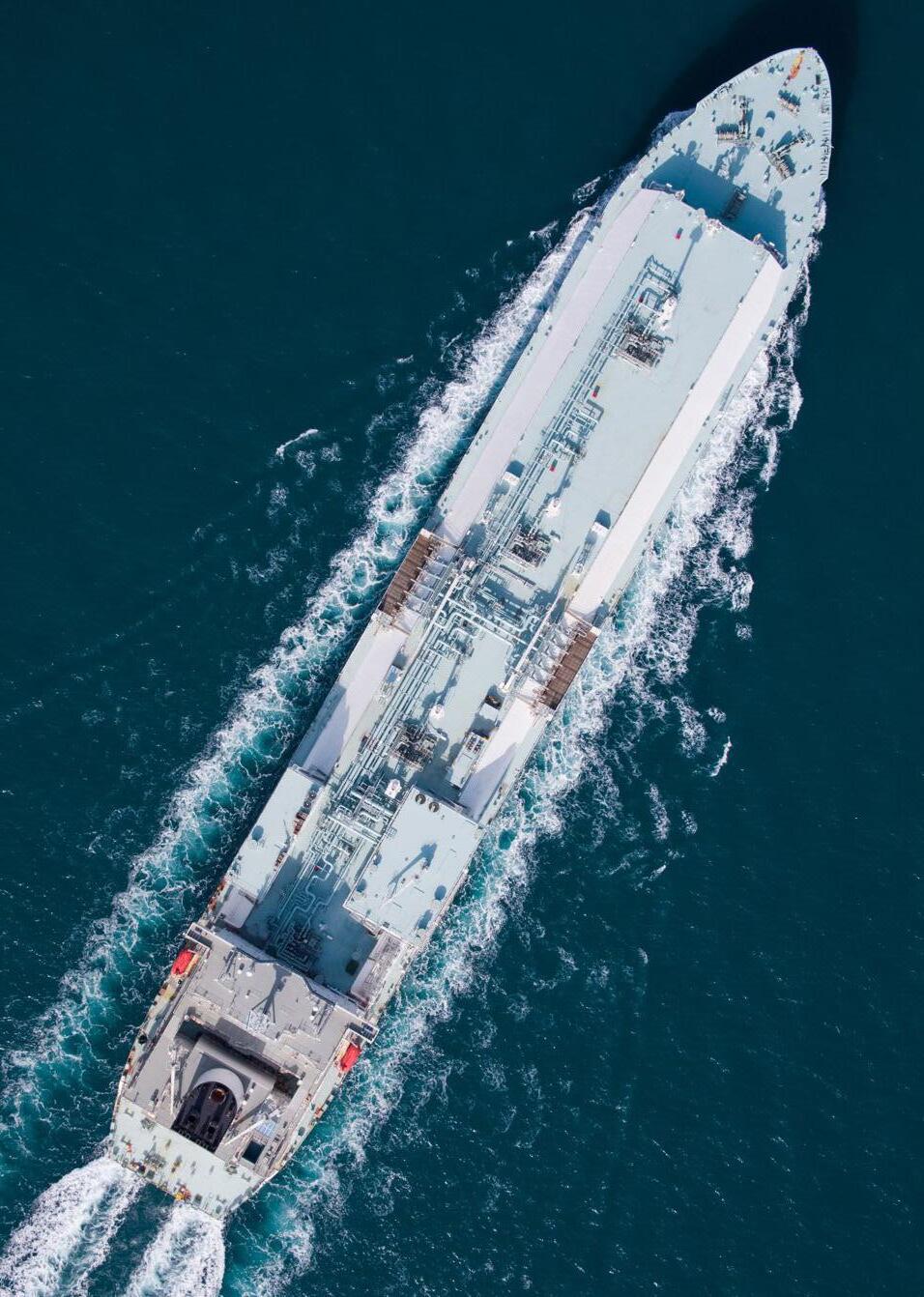
The Minerva Gas first Sustainability Report is published at a time when the shipping industry is undergoing a transformation process caused by the rapid technological advancement, the requirements and targets set towards the decarbonization of our industry, as well as the economic, and social changes due to the ongoing geopolitical crisis/developments.
With that background in mind, we welcome the opportunity to provide our perspective on sustainability within Minerva Gas and the wider LNG industry.
Minerva Gas aims to provide sustainable LNG transportation services by taking active responsibility for the society and the environment that we operate in, acknowledging that business development must balance social, economic and environmental sustainability.
Recognizing that the environmental, social and corporate governance (ESG) considerations may impact the company’s ability to execute its business strategy and create value over the long term, we have consolidated our sustainability efforts for the first time, and we continue to integrate same further into our business.
Minerva Gas fully embraces the UN Sustainable Development Goals and recognizes that fighting climate change and to ultimately reach carbon-zero is the grand challenge of our time. We are fully committed not only to meet, but to exceed the 2030 and 2050 IMO targets for the reduction of CO2 emissions and carbon intensity of international shipping. To further emphasize this, our fleet vessels perform at least 30% better than the current requirements.
Minerva Gas intends to continue investing in the most technologically advanced ships, industry pilot projects and partnerships that will enable the decarbonization of LNG shipping transportation. In this respect it should be noted that in 2021 Minerva Gas was the first ship management company to join the Mærsk Mc-Kinney Møller Center for Zero Carbon Shipping as a Mission Ambassador.
2021 has been a challenging year mainly due to the prolonged impact of the COVID-19 pandemic, however; it should be noted that our seagoing and shore personnel responded with resilience and commitment and continued to do what they do best: serve our customers by moving cargoes safely, reliably, and sustainably.

In Minerva Gas we believe that our people are the Company’s greatest asset and a critical parameter for our success. We value and respect each other, we care about the safety, health and well-being of our personnel both onboard and ashore, thinking of ourselves as a "family".
During 2021 the training program of our in-house training center “ATHINA” was further enhanced and this is a practical example of our ongoing efforts to continually invest in our people in developing and empowering a highly competent workforce that has the right skills to perform their roles effectively and drive improved business performance through safe, compliant, efficient and reliable operations.
Throughout 2021 LNG demand has continued to grow despite a more challenging global economic environment. Looking forward ahead and taking into consideration the commitment showcased by major energy providers towards the production and supply of LNG we are certain the market will continue to outpace itself when compared to other commodity sectors.
We believe in LNG as a transitional fuel and its important role towards achieving the decarbonization goals as set out by the IMO, and we remain committed in providing safe and efficient energy transportation to support the sustainable development of our society.
In producing this sustainability report we have engaged our stakeholders to identify the ESG issues that matter most to them, and we will continue to take their input into account while designing our future strategy in ensuring the long-term creation of value and success for Minerva Gas.
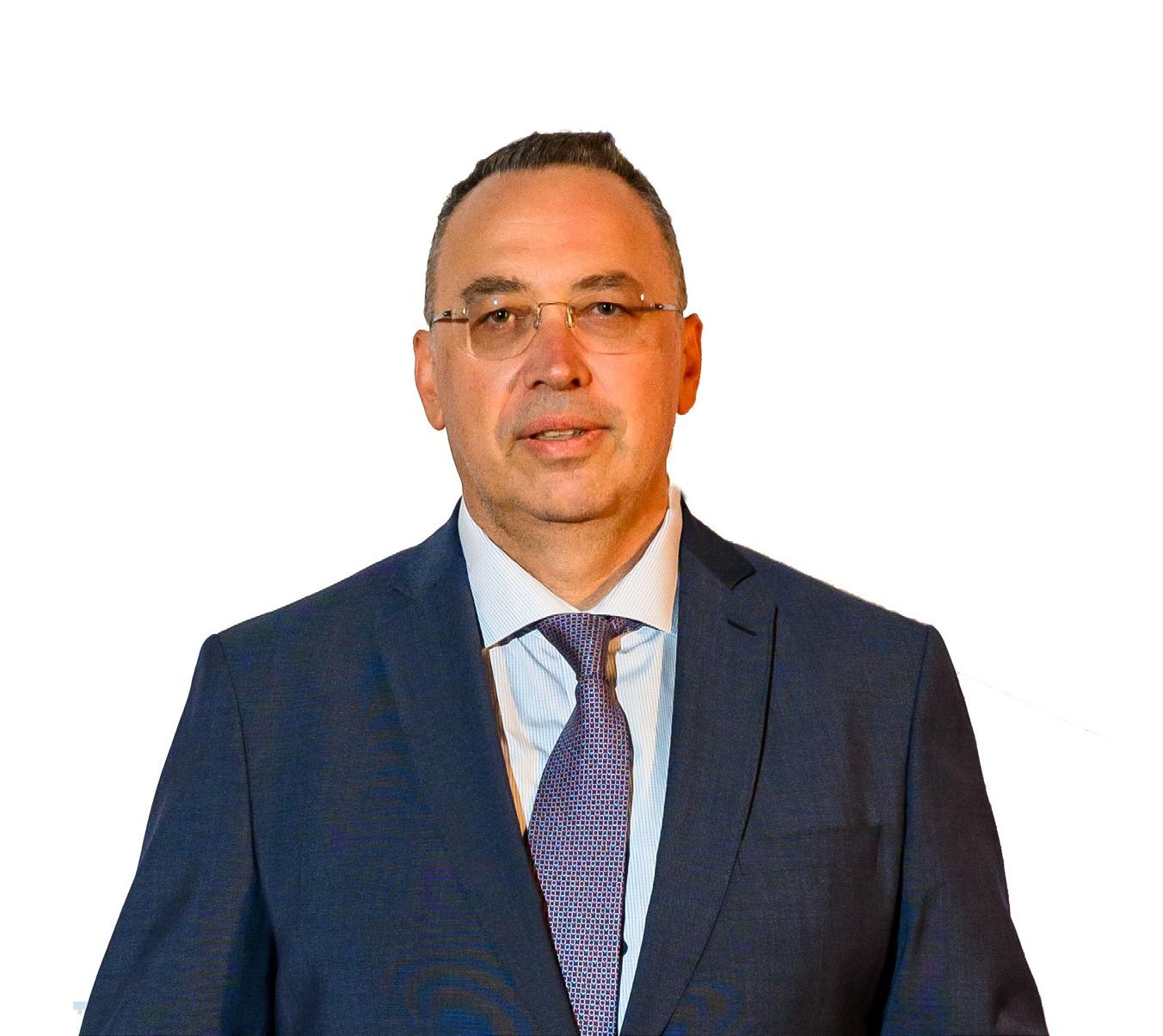
Sokratis Dimakopoulos Chief Operating Officer


Minerva Gas Inc. has been established in 2018 as a dedicated in-house ship-management company aiming to provide quality services to the LNG transportation marine supply chain.
The company operates out of its headquarters in Athens, Greece and benefits from decades of experience within the maritime industry as an offspring of Minerva Marine Inc., a private, third generation, family company with a proven track record of setting out best practice industry standards.

Minerva Gas Inc. manages and operates a fleet of 2-Stroke, latest generation, state of the art LNG Carriers with a clear focus to provide safe and efficient LNG transportation, having the safety of life at sea and the protections of the environment as our prime consideration.





4
EXISTING FLEET

1
VESSEL UNDER CONSTRUCTION
114
28
SEAFARERS SHORE-BASED PERSONNEL
ROTTERDAM MARINE SUPERINTENDENT


HOUSTON TECHNICAL SUPERINTENDENT
ODESSA MANNING AGENCY


ATHENS REGISTERED OFFICE & ATHINA TRAINING CENTER CHIOS MANNING AGENCY
S. KOREA SHI NEWBUILDING SITE OFFICES


MANILA MANNING AGENCY
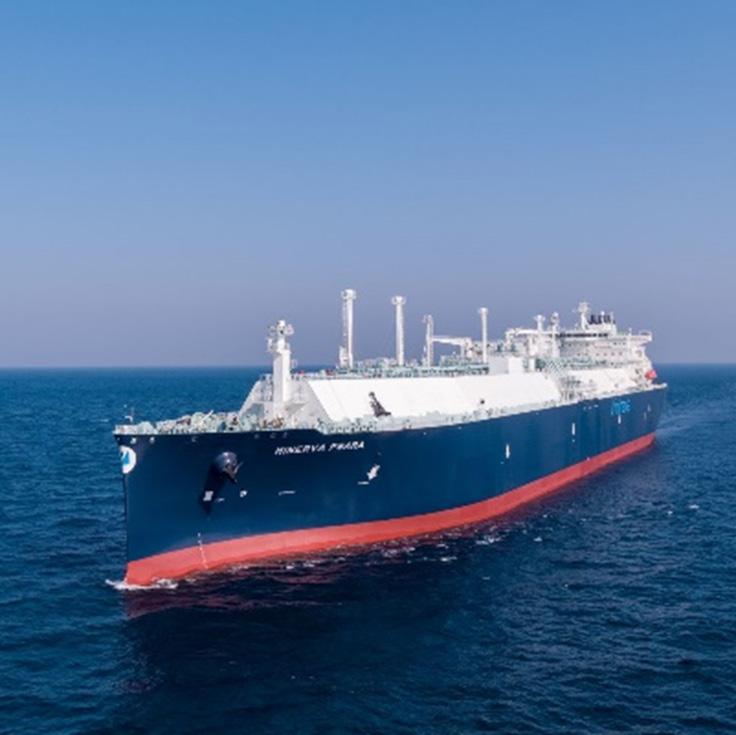




Year Built: 2021
Builder: DSME
Cargo Capacity (m3): 173,400
Cargo Containment System: No96 GW
Propulsion: ME-GI
Reliq. System: FRS
Year Built: 2021
Builder: SHI
Cargo Capacity (m3): 174,000
Cargo Containment System: Mark III Flex +
Propulsion: XDF
Reliq. System: Subcooler
Year Built: 2021
Builder: DSME
Cargo Capacity (m3): 173,400
Cargo Containment System: No96 GW
Propulsion: ME-GI
Reliq. System: FRS
Year Built: 2021
Builder: SHI
Cargo Capacity (m3): 174,000
Cargo Containment System: Mark III Flex +
Propulsion: XDF
Reliq. System: Subcooler
Year Built: Under Construction
Builder: SHI
Cargo Capacity (m3): 174,000
Cargo Containment System: Mark III Flex +
Propulsion: XDF
Reliq. System: Subcooler

OUR PURPOSE
Guides our future
Safe and Efficient energy transportation to support the Sustainable Development of our society.
OUR MISSION
Navigates us safely
Minerva Gas is committed to providing ship management services of the highest quality while adding value to our stakeholders, our people and the society.
OUR VISION
Draws our course
Our aim is to be the shipping company of choice, recognized for its people, its performance, and business ethos.
Anchor us tight
Care for our People
Health, Safety, Security, Quality, Energy Efficiency and Environmental Excellence
Operational Excellence
Ethical conduct
Partnership
Operate in a safe and controlled condition.
Follow safe work practices and procedures.
Operate within design and environmental limits.
Ensure safety devices are in place and functioning.
Report promptly any unsafe act/condition that you observe.
Identify the hazards, assess the risks and implement the required risk control measures prior to a work activity.
Be prepared to respond to an abnormal situation.
Comply with all applicable rules and regulations.
Maintain integrity of dedicated systems.
Strive to meet or exceed costumer’s requirements.

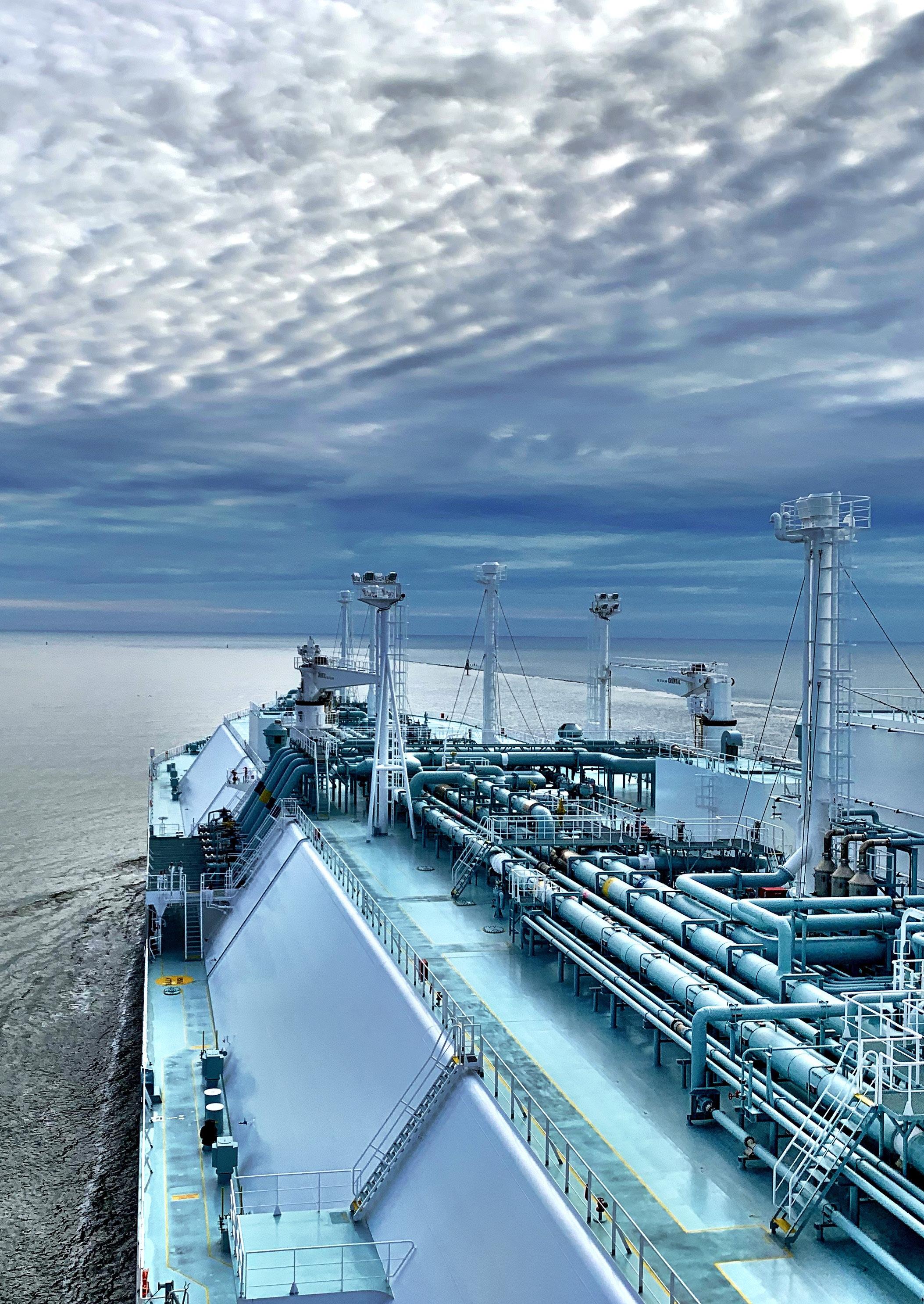
Considering the recent establishment of Minerva Gas, ESG has always been at the forefront as an integral part of our daily operations.
To this extent we have implemented early on the policies, procedures, tools, and systems required to address all the critical aspects of Sustainability.
The company has developed its objectives and goals for ESG strategy implementation and performance, which are monitored using a standardized process to ensure continuous improvement.
As our organization grows and progresses along the ESG path, we recognize the importance of being ahead of the curve and are committed to continuously evolving our procedures to maximize our contribution and meet the increasing expectations of our stakeholders.
Our aim is to provide sustainable LNG transportation services by takings active responsibility for the society and environment we operate in, recognizing that business development must balance social, economic and environmental sustainability.
To achieve this goal, we have put in place the following Sustainability Policy and we are committed to:
• Managing proactively the risks and opportunities associated with our activities to prevent harm to people, assets and the environment.
• Investing in our people, ensuring that they thrive at work by providing an engaging, inclusive and inspiring work environment.
• Reducing our greenhouse gas emissions, helping to mitigate the effects of climate change, ensuring a safe, efficient, and accessible energy supply as well as a sustainable energy transition.
• Conserving the oceans and marine resources, continuously improving waste and water management processes.
• Operating based on responsible business practices, living by our Code of Conduct
• Adjusting our activities in support of the UNDP Sustainable Development Goals.
• Conveying our culture of sustainability to the entire value chain, forming partnerships and collaborations with other stakeholders
• Responding to stakeholders timely and transparently, based on economic, environmental, and social performance indicators which are published in the Company's reports.
• Being a responsible and trusted member of the communities in which we live, work, and conduct business.

Our goal is to ensure the adoption of robust corporate governance practices throughout the organization. This is ensured by adopting highest level of ethical standards while conducting business with our partners and other stakeholders. Aligned with the ISM code and other industry standards requirements, our efforts towards operational excellence are supported by series of best practices from cybersecurity to anticorruption and continuous improvement.
We have established a dedicated Energy & Environment department that addresses current and future environmental and emission challenges. We have advanced climate goals in place that exceed compliance with the expected requirements and industry standards.
One of our top priorities is to enhance the competence and support the development of our seafarers and shore personnel. Our in-house training center (The ATHINA Maritime Learning and Development Center) is a significant investment towards the future of our people and a key component of our organization's sustainability initiatives.
We want to share our expertise, successes, and failures with our strategic partners and the industry organizations so that we can all learn from one another's experiences, drive innovation and support the common effort towards decarbonization.
Our outmost priority remains the safety and the well-being of our people. We care about our employees and support them in their personal and professional development by providing all the necessary tools and resources.
We constantly interact with the communities in which we operate. and actively support the areas in which we operate that are most in need
We strongly believe that maintaining the trust of our stakeholders is key towards achieving our longterm sustainability commitment. We value the thoughts and feedback received from both internal and external stakeholders; therefore, we actively engage with all stakeholder groups, including sea-
Key Stakeholder Groups
Seafarers
Shore-based Personnel
Charterers & LNG Terminals
Supplier’s & Business partners
Industry organizations & Classification Societies
Communities

farers, shore-based personnel, charterers & LNG terminals, suppliers & business partners, industry, organizations & classification societies. Being a learning organization, and as part of our constant efforts to monitor and improve our procedures, we systematically evaluate our stakeholders needs and expectations.
Engagement Approach
• Annual satisfaction surveys
• Performance Appraisal
• Officer Forums, onboard visits, the company's feedback mechanism, and the briefing and debriefing procedure.
• Internal meetings and seminars
• Open reporting system
• Performance appraisal
• Regular surveys
• Internal meetings and seminars
• Customer feedback survey for 1-2 times/year
• Regular meetings (weekly/monthly depending on the function)
• Terminal evaluation for each load/discharge operation
• Regular calls
• Supplier audits
• Membership
• In-person Meetings
• Conferences
• Various initiatives to contribute to different communities
Minerva Gas is associated with a number of leading industry organizations, working together to achieve the mission of promoting safe and environmentally sustainable shipping practices

As a member of SIGTTO, Minerva Gas is fully aligned with the Society's mission to promote safe, environmentally responsible, and reliable shipping and terminal operations.

By joining HELMEPA, the human element of Minerva Gas, from seafarers to top management, has voluntarily committed to supporting the goals of Safe Ships in Clean Seas.


Minerva Gas is a longstanding member of Intertanko with active participation in various committees with the aim to assist in shaping the regulatory framework and maintain high industry standards.


Minerva Gas actively participates in the working groups and committees of Classification Societies with the aim to provide its view and feedback in the development of industry rules and regulations.

Minerva Gas has joined the center's efforts as a “Mission Ambassador” to facilitate and accelerate the development and deployment of new technology solutions for the decarbonization of the global maritime industry.
The release of our first sustainability report just one year after commencing our commercial operations emphasizes our commitment towards ESG practices. In this report, we have prioritized the sustainability issues and challenges that are most important to our stakeholders and aligned with the sustainable growth of our organization.
We surveyed and consulted both our internal and external stakeholders, and the materiality assessment is based on the responses collected from both groups.
We have identified 18 ESG topics that are important to our organization and the wider industry through the materiality assessment. These topics have gone through management prioritization based on the stakeholder focus and the potential impacts they might have on our day-to-day business and operations.
The views of both our internal and external stakeholders are aligned in terms of identifying social and governance issues, such as the health and safety of employees, ethics and regulatory compliance, and operational excellence, as a key priority.
As the industry progresses towards decarbonization, environmental issues such as emission reduction, energy management, and climate change stewardship are gaining momentum.
By identifying the primary areas of interest for our stakeholders and business, we can report concise information that provides a clear picture of our progress and targets our resources and efforts to the most critical sustainability issues.
We intend to reevaluate the objectives and conduct a thorough materiality analysis regularly to ensure that our processes and goals are following the latest market requirements and trends and additionally to uncover issues that are important but not currently addressed.
Our actions and progress in achieving our materialityrelated objectives are described throughout the report.

Data Privacy & Cyber Security
Employee Development & Talent retation
Responsible Supply Chain
Data Privacy & Cyber Security
Research & Innovation
& Regulatory Compliance
Climate Change & Environmental Stewardship Resources & Water conservation Energy Efficiency & Management Emissions Management
Anti-corruption & Anti-bribery
Economic Performance & Business Strategy Anti-corruption & Anti-bribery Business Relationships
Employee Welfare & Diversity
Employee Health & Safety Operational Excellence & Assurance
Climate Change & Environmental Stewardship Resources & Water conservation
Community Engagement
Employee Development & Talent retation
Responsible Supply Chain
Research & Innovation
Business Relationships Ethics & Regulatory Compliance Risk Management Fair Labor Practices
Employee Health & Safety Operational Excellence & Assurance
Energy Efficiency & Management Emissions Management
Employee Welfare & Diversity
Community Engagement
Economic Performance & Business Strategy

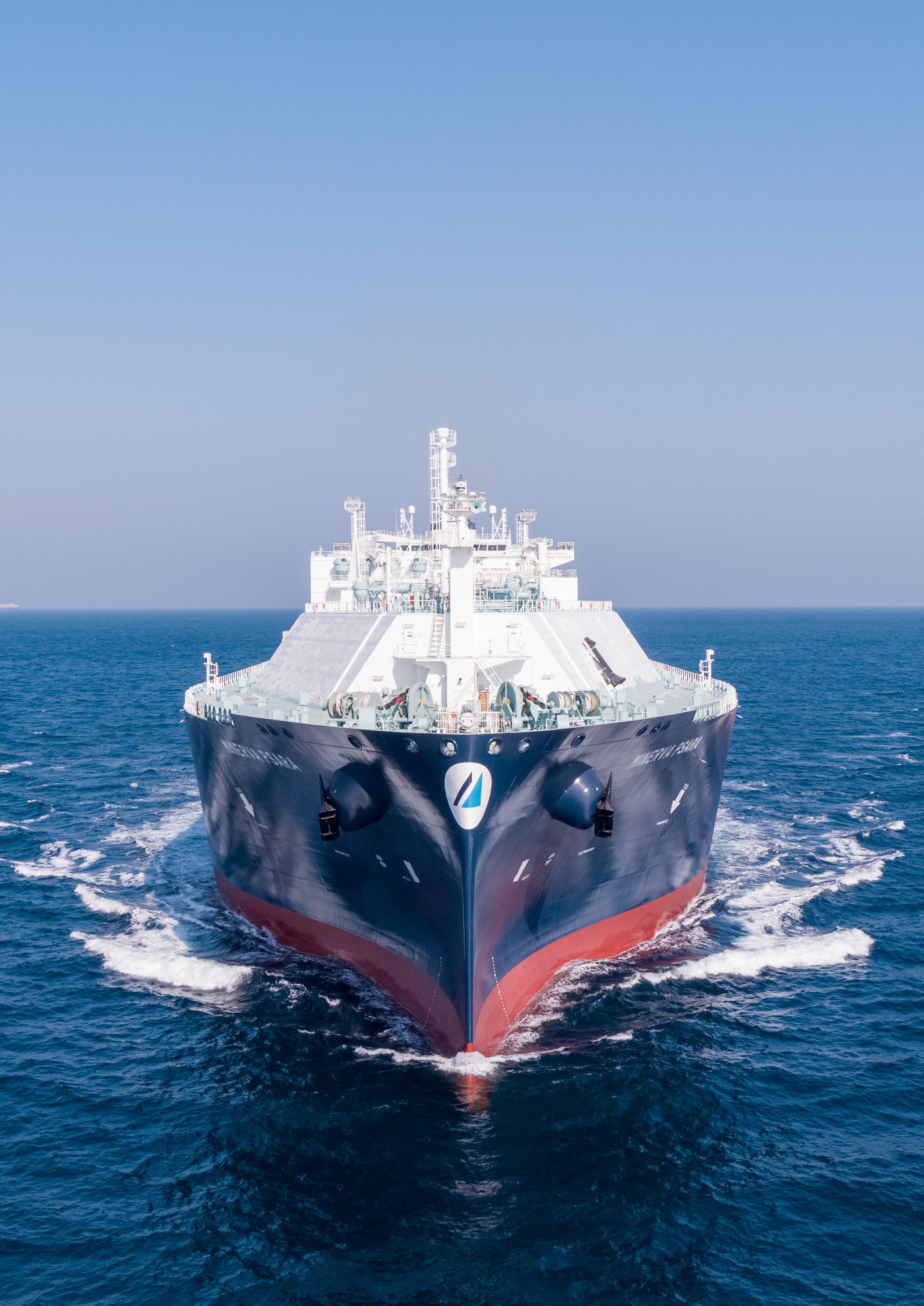
A robust corporate governance is the cornerstone of a trustworthy and reputable company. The path to long-term sustainability requires that we manage our progress and continue to learn from our experience and peers. To ensure compliance and continuous im-
Management Review Committee
Purpose: To assess the overall effectiveness of the Company's HSQE performance, review the MGMS, policies, objectives, and targets, and identify opportunities for improvement.
Purpose: To ensure better coordination and planning of the Company’s activities, review the progress of the various projects underway, and evaluate proposals for MGMS update/development.
Purpose: To monitor the developments in regulations and industry requirements and assign responsibilities and target dates for initiating the relevant actions to ensure compliance, including updating the MGMS.
Purpose: To analyze the learnings from incidents, identify trends, and establish measures to enhance HSQE performance, including the MGMS.
Purpose: To keep all Departments up-to-date on the fleet's status and operational issues and coordinate the activities
provement, Minerva Gas has established six committees to evaluate the effectiveness of current policies and objectives, monitor performance, learn from experience, and collect ideas for future improvement.
Purpose: To discuss all HSQE aspects, including safe working practices, increase HSQE awareness through a commitment to the MGMS, promote safe environmental practices, and review incidents, near misses, and lessons learned.

Frequency: Meets every three months at the Management Review Meeting (MRM)
Frequency: Meets every month
Participants: CEO, COO, DPA, all Company’s Managers
Participants: Top Management and the Company’s Managers
Frequency: Meets every three months
Participants: Top Management and the Company’s Managers
Frequency: Meets every three months
Frequency: Meets every week
Frequency: Meets every month
Participants: COO, DPA, HSQ & Marine, Energy and Environmental, Marine Personnel, Technical, Operations, Purchasing Managers and any other Senior personnel of these departments in accordance with the Manager’s decision.
Participants: Representatives from Operations, Technical, HSQ & Marine, Marine Personnel, Energy & Environmental, Purchasing, IT and Insurance Departments and the CSO.
Participants: Master, Officers and Ratings

Our risk management procedure adheres to the requirements of ISO 31000. Risk management is an integral part of our day-to-day operations, and it applies to every project and task we undertake, allowing us to continuously improve.
Risk assessment is the pillar of our Safety Management System (SMS). To develop our SMS, we carried out extensive gap analysis considering all the hazards and physical barriers and assess our mitigation strategies.
For the assessment, we generate a risk matrix that follows the 5x5 rule that maps out the effects against the
probability. We have divided the consequences into five major categories, ranging from the least severe to the most severe of the probable outcomes. The risk matrix defines our threshold, the zones where risk levels are acceptable and those where they are not, and the measures that we must take when assessed over the threshold.
Taking the management of our entire LNG Carrier fleet in-house has been the Company’s first priority since its establishment in 2018, as in Minerva Gas we strongly believe that this is the best way to execute ship management services of the highest quality and standards, because:
• We care more for our personnel and vessels than any other third part vessel manager
• We know our vessels better as they have been built under our direct supervision.
• We have established an LNG experienced and competent shore-based team, responsible for the fleet LNG Carriers’ operations as of “day 1”.
• We have employed competent and experienced LNG Officers and we have trained our Minerva tanker Officers in LNG operations in the in-house Maritime Training Center “ATHINA”.
• We use the Minerva Group robust organization/support structure.
• We consider “Taking the management in-house” as a client expectation.
To ensure a smooth and successful change of management the Company established a comprehensive and detailed Management of Change process, including a comprehensive list of measures with specific timelines and responsibilities set out in eight (8) Volumes of Action Plans: Crewing - Shore Personnel - SMS Development & implementation - ISM Certification - LNG Majors/Charterers acceptance - Maintenance & PMS data - IT/Software Systems - Ship-specific takeover Checklist.
The final milestones that enabled Minerva Gas to take the management of the first vessel in-house were:
• The issuance of the full-term DOC for Gas Carriers on the 23rd of December 2021.
• The initial TMSA submission in OCIMF on the 21st of January 2022.
The fact that Minerva Gas has been accepted by TotalEnergies, the Charterer of Minerva Limnos, for long-term LNG business is worth noting as TotalEnergies is not only a Major LNG Charterer but also an Organization with very demanding and robust vetting/clearance processes.
Minerva Gas is in the process of transitioning the remaining LNG fleet vessels under in-house management with a set goal to have this accomplished by end of 2022.
Operational Excellence for Minerva Gas remains a top priority. To ensure that our operations are flawless and not only meet, but exceed our charterers expectations and needs, we have established a team of professionals with a high level of expertise in the gas
We have entered into maintenance agreements with all our major equipment suppliers so our fleet vessels can retain high reliabilitry levels. In addition, we have tools for forecasting that utilize actual data collected from vessel critical equipment and machinery such as the main engines, generator engines, and compressors. Additionally, advanced technologies facilitate instantaneous communication between the vessel's manufacturers and the vessel itself. The manufacturers also provide reports assessing the condition of the vessel's primary equipment. As a result, we can gain insight into what we will need to do in the future and how to plan maintenance.

industry. To achieve operational excellence, we place a premium on three key elements: proactivity, interdepartmental communication/collaboration, and attention to detail.
Minerva Gas anticipates the actions that need to be taken to address energy and environmental challenges, compliance duties, and the associated risks and opportunities. Planning is critical in terms of achieving our goals and objectives, and is built basis the below:
• Identification of energy and environmental aspects and determination of those that are significant
• Identification of applicable legal and other requirements to which the Company subscribes
• Establishment of internal performance criteria, where applicable
• Establishment of goals and action plans to achieve them.
Through careful planning, we aim to allocate our resources to the areas that will have the greatest impact towards achieving our objectives. The information provided by the planning procedure is integrated into the company's overall decision- making process. Specifically, decisions on system enhancements, training programs, vessel operations, maintenance, and repair.
Planning is an ongoing process used to establish and execute aspects of the Energy Environmental Management System (EEMS), as well as to maintain and enhance them in response to changing conditions. The planned actions may include the establishment of energy and environmental objectives, or they may be included in other EEMS procedures singly or in combination.

We establish and organise our goals and objectives under three pillars: the reactive, active, and proactive improvement processes.
In the unfortunate event of an incident, or whenever a deficiency or observation is identified during an inspection, we have procedures in place to identify the source of the problem and ensure that we learn from the experience. The HSQ-Marine department has an incident investigation division, which is one of our most effective, reactictive improvement mechanisms.
We constantly monitor and measure our performance. Our primary tools are independent and real-time inspections and audits.
For Minerva Gas, innovation is a one-way path full of opportunities and challenges. We operate a modern fleet of vessels, and we make it a point to collaborate with our charterers, equipment manufacturers, and shipyards in maintaining and developing advanced LNG carrier designs that promote efficiency, reliability, and an advanced GHG profile. Minerva Gas is a member of several leading industry organizations and works closely with the main classification societies to stay abreast of the latest developments. Our interaction with industry stakeholders enables us to closely monitor test and implement new technologies. Our in-house training center is a great asset in helping us promote innovation and the implementation of new technologies, as it offers our people the opportunity to learn and familiarize themselves with such new technologies and practices.
Some of the proactive measures we are taking to ensure continuous improvement include risk assessments, safety and behavioral programs and campaigns, training, and personnel engagement.
““We continue to invest in the development of new technologies. We are devoted to this by providing optimization, maintaining environmental compliance, and anticipating future developments.”
Compliance and business ethics remain fundamental to our business. When dealing with our customers, partners, and other stakeholders, we adhere to the highest standards of ethics and integrity. Minerva Gas
The Company has adopted a Code of Conduct and Ethics (the "Code") which is applicable to all Company’s employees, managers, agents , sub-contractors and ship personnel serving on board vessels managed by the Company (hereinafter the “Individuals”/“Covered Persons”).
The Code provides basic guidelines regarding the minimum requirements expected by the Individuals and reflects the Company’s core values and commitment to manage its business with integrity.
has implemented a management system with the necessary policies, procedures, and resources to ensure compliance and achieve this goal.
• Conflicts of Interest
• Corporate Opportunities
• Confidentiality and Personal Data Privacy
• Environmental Compliance
• Anti-money laundering and combatting terrorist financing
• Anti corruption, gifts and hospitality
• Market Abuse and Market Conduct
• Ethical Conduct
• Protection and Proper Use of Company Assets
• Compliance with Laws, Rules and Regulations
• Harassment and Bullying
• Enforcement and Duty to Report
• Open Reporting Program
• Prohibition of forced labour, child labour and human trafficking
employees have been made aware of the company's anti-corruption policy. Confirmed incidents of corruption
Minerva Gas has implemented the Open Reporting Program to increase transparency. The purpose of the program is to enable all individuals (i.e., all employees, seafarers, contractors and subcontractors, agencies, partners, and consultants) to raise concerns when they

discover evidence of misconduct. We encourage our employees and third parties to report issues without fear of retaliation, harassment, or disciplinary action. We are committed to protecting our reporters at every stage, including times when they reveal their identities.

Cyber security and information protection have become increasingly important in the maritime industry. Minerva Gas continues to invest in improving information security measures during business operations to reduce cyber risks and become more resilient.
We have established a Cyber Security Policy to ensure that all operations are safe and secure. Our commitment to implement and constantly enhance a documented cyber security management system, following the ISM Code and ISO 27001 standard, is reflected in this policy. We guarantee the confidentiality, availability,
and integrity of information and operating systems onboard and ashore.
We evaluate the cyber security risks associated with our operations and implement adequate measures through various means.
1
IDENTIFY THREATS AND VULNERABILITIES
Our company identifies different categories and stages of cyber-attacks as well as our vulnerabilities
4
INCIDENT RESPONSE AND RECOVERY PLAN
It is important to investigate an incident and formulate an appropriate response and recovery plan to prevent it from happening once again

2
RISK ASSESSMENT
Regular risk assessment studies are conducted based on the threats and vulnerabilities
3 PROTECTION MEASURES
A wide range of protection measures to protect our data and information, including access control, passwords, training, devices control, etc. have been implemented.
Our company has deployed a lot of technical measures to enhance our hardware security, including a new next-generation firewall, encrypted laptops, security on endpoints, encrypted cell phones, and USB blocking.
Regular cybersecurity training and awareness campaigns are conducted to remind our employees of the importance of protecting their personal information and privacy.
We monitor any cybersecurity incidents to analyze the trends and perform investigations to identify existing gaps and areas of improvement. We invite third parties to perform vulnerability assessments and penetration tests both at the office and the vessels.
Substantiated complaints received concerning breaches of customer privacy
Identified leaks, thefts, or losses of customer data



At Minerva Gas, one of our core priorities is to care for our people. Every employee is a member of the Minerva Gas family, and embraces the company's values, visions, and philosophy.
Minerva Gas believes that inclusivity and diversity are essential to the shipping industry. We recruit people with various backgrounds and perspective in our pursuit for balance in the way we work . We provide equal opportunities to all employees and have implemented a fair promotion scheme based on effort, performance, and skillset.
As stated in our Code of Conduct and we have zero tolerance for any form of harassment and bullying. We aim to ensure that all personnel is treated with dignity and respect and that they extend the same
to others. Harassment and bullying must be reported to the company to be effectively treated always with confidentiality.
As a learning organization, it is critical to continue and improve current approaches and policies to promote diversity, equity, and inclusivity. To increase gender diversity in top management, we constantly seek talented young female professionals and create a development path for them to gain the necessary experience and competence to advance to management positions.
We rigorously adhere to the MLC (Maritime Labour Convention) and ILO (International Labour Organization) regulations. Our Code of Conduct and Ethics demonstrates our commitment to ensuring an environment free of human trafficking, forced labor, and
illegal child labor for our employees. All contractors, subcontractors, vendors, suppliers, and others with whom the Company conducts business shall not be complicit in any act constituting human trafficking, forced labor, or child labor.
Employees covered by collective bargaining agreements

Age Distribution Age Distribution
Learning and the constant pursuit towards improvement are embedded in the culture of Minerva Gas. We recognize the importance of the competency of our seafarers and shore-based personnel, and therefore, we invest and support their career and skill development through high-standard training programs and performance appraisal.
Following our philosophy of continuous learning, we implement a variety of methods to encourage our staff to continuously enhance their skill sets and cultivate a learner's mindset. Based on their responsibilities and interests, we have designed a training matrix for our seafarers and shorebased personnel that includes both essential soft skills (such as leadership, project management, and coaching) and useful technicalskills (such as Navigational, Technical Engineering and Safety/Environmental related courses).
Additionally, we evaluate our employees using a performance appraisal tool to create appropriate career development paths for each one of them and to better access their potential. The department manager conducts appraisals for shore-based personnel twice a year which is based on a set of targets and competencies. At Minerva Gas, we value employee feedback, which is why we provide opportunities for each employee to evaluate their manager, with the assessments contributing to the manager's appraisal rating. An open appraisal method for seafarers is used to identify weak points on board and help our crew members improve their performance.
Minerva Gas places a high value on each employee's personal growth. Better training and knowledge of the sector, in our opinion, can result in a team composed of individuals who are both highly competent and well-versed in their field. As a result, we encourage all employees to seek higher education degrees
88% of our shorebased personnel have received at least 1 specific inhouse training

88% of our seafarers have received at least 1 specific in-house training
and gain industry knowledge through the Higher Education Reimbursement Scheme. To support our employees, we have a policy in place and formed a committee to evaluate the applications from employees who intend to pursue master/postgraduate degrees relevant professional certification.
9.56 days average training time for seafarers
41.4 hours average training time for shorebased personnel
100% of employees have received a regular performance and career development review
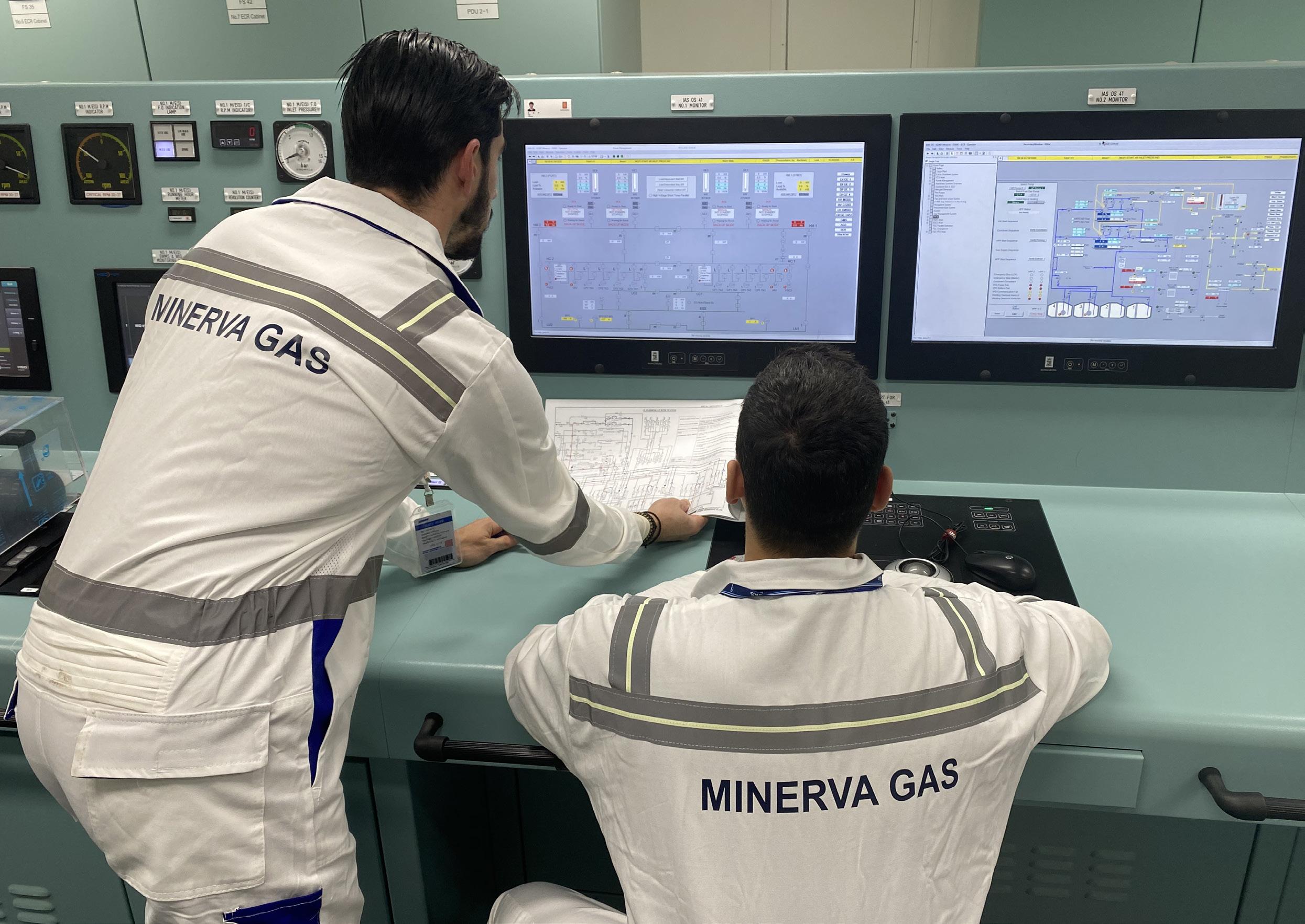
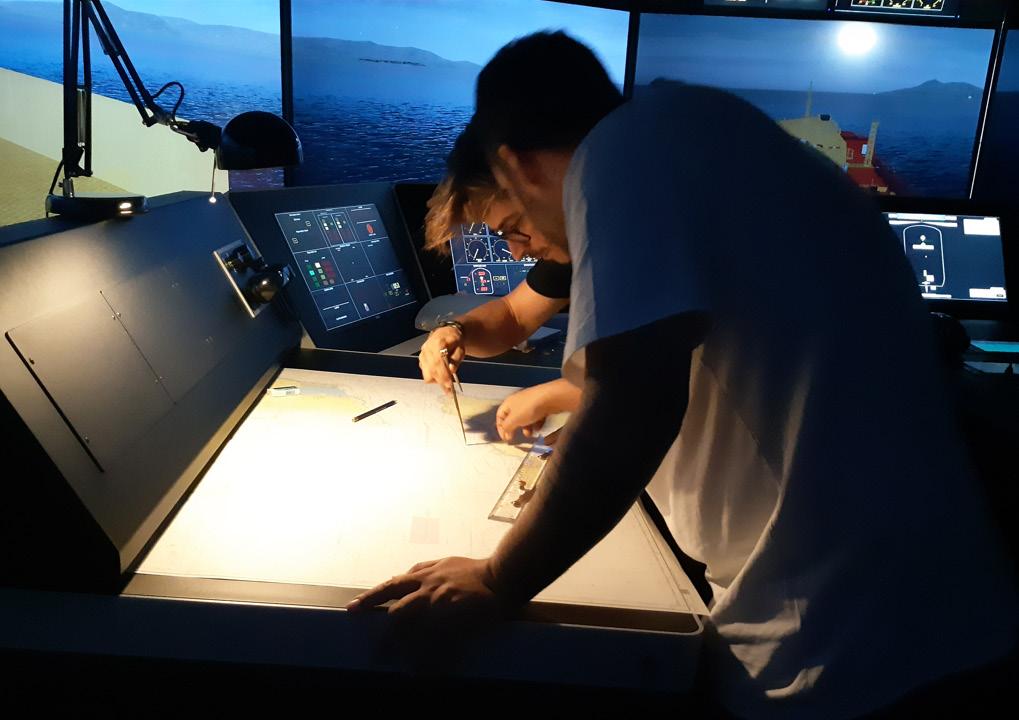
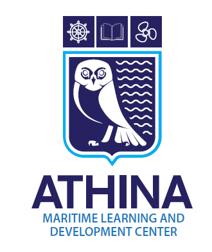
Our Principals established the ATHINA Maritime Learning and Development Center recognizing the significance of continuous learning. We consider our training center one of the most important cornerstones of our organization; it is equipped with cutting-edge training facilities and marine simulators. The Center highlights the Minerva Gas culture as a learning organization and our commitment to provide the most effective training and establish a team of highly competent seafarers.
A quarterly Training Program for all seafarers and ranks is published, which includes seminars, courses, and conferences delivered by qualified and experienced trainers. Each quarter, both seafarers and shore-based personnel can register for these seminars and conferences.
The Training Center provides a variety of technical training courses that can be characterized as Navigational, Technical & Engineering, Safety & Environment, and Cargo Handling. This training would improve our seafarers' competence, hence improving the overall quality of our ship management services.


Ship Handling Simulator & Bridge Teamwork
Passage Planning with the use of ECDIS
Engine Room Resource ManagementEngine Simulator
Fuels' Management - Bunkering Procedures
Electrical Welding (Manual Metal Arc)
Pneumatics – Automation
High Voltage Shipboard Installations
SAFETY, ENVIRONMENTAL COMPLIANCE & SECURITY
Environmental Compliance – MARPOL 73/78
Incident Investigation
Safety Officer and Risk Assessment
Ship Security Officer
Drills and Exercises
CARGO HANDLING
LNG Cargo and Ballast Simulator
LNG Cargo Operations - SIGTTO Competence
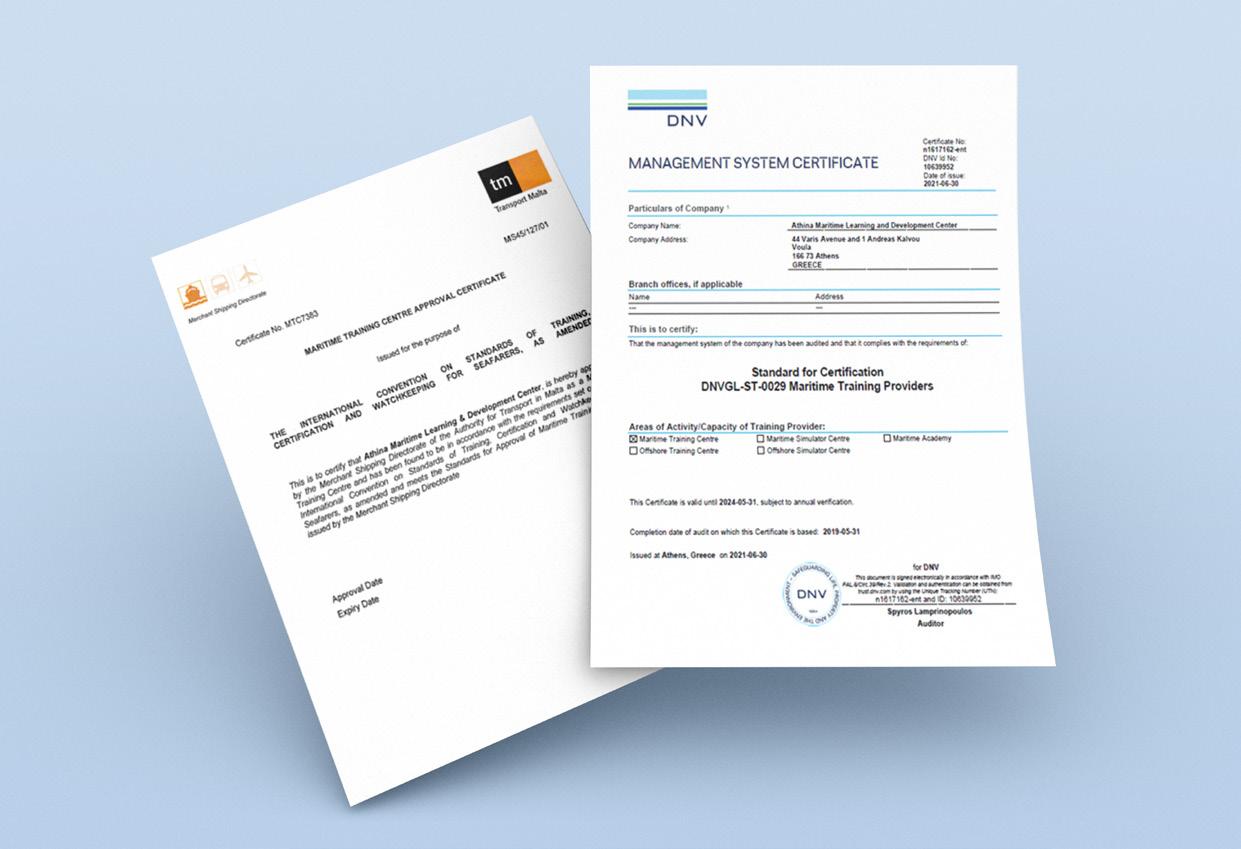


“ “Where Seafarers Always Come First”


In order to continuously improve our training programs, we began measuring the effectiveness and added value of our training courses in 2021. The effectiveness is measured using a four-tier metric that includes the evaluation of our seminars as well as the improvement in the performance of the seafar-
ers who participate in the training. Through this approach, we aim to develop personalized training that meets the needs of our employees and assists them in their continuous improvement by enhancing the competence and skills.
LEVEL 4
The Impact of training on the job for seafarers
LEVEL 3
Knowledge and skills acquired through training
LEVEL 2
Evaluation of training by company’s superintendents and shore personnel
LEVEL 1
Evaluation of training by Officers/Trainees

Furthermore, we have established an initiative known as the quarterly training moment , in which our instructors constantly capture interesting ideas from trainees and turn them into new training projects. These ideas are shared on our website and circulated during our management review meetings.

By integrating the training needs identified through various sources, such as the performance appraisal and training evaluation, we aim to further enhance our training programs to develop the knowledge and skills of our people.
We want to keep investing in our people to assist them in reaching their potential, and increase their competency, as we recognize that the strategy of talent retention is not only about benefits, but also about opportunities.
Minerva Gas is committed to provide shore based employees with all the benefits as per the relevant/ applicable legislation. Besides that, we offer a competitive remuneration package with a series of addi-

tional benefits to motivate our employees, including performance related bonuses , private health insurance, and others initiatives.

Our seafarers are invited to work in the office. One of our organizational goals is to recruit top performing seagoing personnel from within our fleet. The Annual Shore Assignment Plan provides our seafarers with the chance to work in the offices for a certain period
or on a specific project. Overall, it is a great chance for our seafarers to experience our culture and better integrate into our family, while at the same time enabling us to retain our talents.
We place a high priority on the health and safety of our employees, and we try our best to achieve a zero-incident culture at Minerva Gas.
Minerva Gas is committed to always be in compliance with all international maritime safety regulations, including the statutory requirements as per the International Safety Management Code (ISM) and Maritime Labour Convention (MLC). We have implemented a Health, Safety & Quality (HSQ) Policy within the organization to ensure safe, efficient and flawless operations. The policy lays the foundation for the Minerva Gas safety culture and demonstrates the company's dedication to fostering a safe and healthy working environment for all of our employees while also maintaining a high level of services for the benefit of our stakeholders.
Based on the requirements of the ISM Code, the ISO 9001, and ISO 45001 standards, we have established a comprehensive safety management system. The system defines the objectives of our safety performance and keeps monitoring the progress. The experienced team of our HSQ-Marine dept. is responsible for overseeing and managing all HSQ-related activities to ensure compliance with all policies, regulations, procedures, and processes of our controlled documentation and industry requirements. To ensure continuous improvement, we create a strategic plan which identifies the Strengths, Weaknesses, Opportunities & Threats (SWOT) and follows the PDCA Cycle (Plan - Do - Check - Act) strategic management method.
Conduct Risk Assessment to identify the health and safety hazards.
Develop procedures and contingency plans
Set objectives, targets and KPIs to measure performance
Creating emergency response plans
Implement policies and measures
Review the outcomes and performance
Measure and benchmark KPIs and check compliance with set targets
Identify potential actions to improve the current process and integrate into the future planning process
Take preventative/corrective measures to reverse any negative trends
Identify potential actions to improve the current process and integrate into the future planning process
Risk assessment is the core of our safety management system. We conduct a risk assessment of the hazards that could be found in the workplace, and we implement accordingly the necessary control measures. The evaluation's results and suggestions are then considered

to enhance occupational health and safety. Our safety management system applies to all our employees, and all contractors are familiarized with the requirements of the relevant sections of the safety management system according to their scope of work.
We strongly believe that training plays a significant role in promoting our safety culture amongst our employees. Our ATHINA training center has carried out a series of health and safety training for both seafarers and shore-based personnel.
Minerva Gas has commissioned a certified Occupational Doctor who visits our premises once a week. The Occupational Doctor conducts a health checkup for new employees and issues a pre-employment health certificate to state whether employee is medically fit for the position. Furthermore, a Safety Engineer is also responsible for inspecting the working conditions within the office and ensuring that they are following the relevant legislation. All seafarers are required to undergo this pre-employment medical examination before embarkation, and their health condition is under constant monitoring to ensure that they are physically fit for duty onboard.
To further complement the company’s priorities on its people, and specifically keeping in mind our seafarers’ needs, Minerva has commissioned the services of Med Solutions’ global team which consists of physicians of various specialties (internists, infectious disease specialists, cardiologist, dermatologist, orthopedic specialist and other specialists as needed), physician’s assistant, nurse case managers and health administrators and epidemiologists.
Med Solutions have streamlined their process as follows:
For medical assistance onboard 24/7 (telephone and e-mail), they provide specific instructions immediately through one of their specialists. Their medical team consists of health professionals in Greece, the Philippines, Panama, Brazil and the US along with cooperating physicians in various other locations worldwide. Once initial instructions are provided, case is followed up through closure.
If examination in port is required, they supervise and coordinate the process in cooperation with our local agent, in order to provide guidance regarding examinations required and ensure the best available medical care for our personnel. Additionally, their team will always be able to speak to one of our team members regarding ongoing cases, to review progress, plan of action and decide on logistics of further management.
The course is mandatory for the designated Safety Officer who has amongst other responsibilities the role of supervising, controlling, and participating in the work permit system for all works and activities. The training would secure the appropriate safety management skills and competencies require for this role.
Before boarding the vessel or working in the office, all new employees are trained on the health and safety aspects, such as fire safety, evacuation, PPE usage, emergency response, etc.
Onboard Computer-Based Training is mandatory for all Officers and Ratings. We have a library of over 250 training programs that are related to health and safety, including topics such as Personal Safety, Risk Perception and Assessment, Work Permit System, etc.
Our Training Center offers a wide portfolio of STCW training courses, industry recommended courses, tailor made seminars for licensed Deck and Engineer Officers, as various Shore Based Staff learnings.
The Training Courses can be broadly divided into the following categories:
- Approved STCW training courses.
- Courses to meet industry Competence Standards, such as SIGTTO LNG Training, Oil Tankers Cargo Handling Simulator Training, Ship Handling, Safety Leadership, etc.
- Courses that provide underpinning knowledge and skills on new technologies, such as Ballast Water Treatment Systems, Electronically Controlled Diesel Engines, Marine Fuel and Lubricating Oils Handling, etc.
- Practical courses such as MMA Welding, Lathes, etc.
In terms of content, the training courses relate to Navigation, Technical/Engineering, Cargo Handling and Management and Safety, Environmental Compliance & Security.
Every month, a facilitator would lead an incident reflective training session with a small group of seafarers by presenting a high-impact incident, its causes and lessons learned using an interactive process.
Performance tracking and monitoring is a critical process to ensure a comprehensive safety management system and create a reliable safety culture. We regularly carry out health and safety audits and inspections both internally and externally.
Regular audits and inspections are conducted by the technical and marine superintendents
Real-time audits are carried out by sailing with the vessel and observing the day to day vessel operations
Annual internal office audits
Monthly inspections on vessels are conducted by the Chief Officer, who is responsible for the safety on the vessel
At Minerva Gas, we keep monitoring and setting targets for safety-related performance indicators, such as near misses, minor injuries, lost-time incidents, and fatalities. As a learning organization, our incident investigation division carries out investigations on every incident to identify the root cause and take the necessary corrective/preventive measures in order to further improve the safety onboard and build up a safer culture for the next generation onboard our fleet.
Port vetting inspections are conducted by third parties
ISM audits on safety management system
External audits conducted by our stakeholders
Port state controls and inspections
Independent audit/inspections on-board fleet vessels
The trends and results are presented and discussed during our Learning Committee meetings and Management Review meetings. Up to 2021, Minerva Gas does not have any incidents nor any detentions regarding health and safety aspects, however, it is important to keep learning from our experience and our stakeholders in the industry to achieve a better performance and promote a more robust safety management system.
Since the beginning of the COVID-19 Pandemic, Minerva Gas and the wider shipping industry have faced numerous challenges.
We have established a comprehensive outbreak management plan to the pandemic to ensure the health and safety of both our seafarers and shore-based personnel.
Onboard our managed fleet, we have set in motion a policy to promote the vaccination of our seafarers.

Until the end of 2021, almost 95% of our seafarers were fully vaccinated. To prevent all seafarers from risk and in order to comply with the procedures of the various ports in different countries, our seafarers are required to perform a PCR test before their embarkation and disembarkation. Additionally, our vessels are also equipped with self-tests to help us track the health status of our seafarers.
To safeguard our shore-based personnel, our HR department has actively developed a series of initiatives in accordance with the governmental regulations.
Creating social value is embedded in our sustainability strategy. We aim to operate in a socially responsible manner, ensuring the safety of people and the environment, through transparent and ethical behavior. We
work diligently with our employees, local communities and internationally recognized bodies to ensure that social factors are integral to our business principles, recognizing that our operations have a global influence.
The education of the next generation is an important pillar with regards to our future development
We participate in various activities to bring our positive attitude and our values to the local communities
PUBLIC ORGANIZATIONS
We cooperate and assist with a number of public organizations, including port authorities, police departments, etc.
VULNERABLE GROUPS
We actively support vulnerable groups through NGOs and a wide range of initiatives
Distribution of Community Engagement Activities
11% MARITIME EDUCATION
Merchant Marine Academy Chios
Merchant Marine Academy Kalymnos
Internship Program –Supporting Maritime Students in acquiring on the job knowledge
24% LOCAL COMMUNITIES
31% PUBLIC ORGANIZATIONS
24% VULNERABLE GROUPS
ENVIRONMENT
We are committed to protect the environment and engage our employees to participate in related initiatives
10% ENVIRONMENT
HELMEPA beach Cleaning Event Recycling
Plastic Free Restaurant



We are committed to protecting the environment and preserving biodiversity and ecosystems' stability by ensuring pollution-free, environmentally friendly, and energy efficient operations.
We have adopted Climate Targets aligned with the IMO and EU decarbonization goals.
We participate and invest in emission reduction or net zero emissions shipping pilot and demonstration projects.
Having identified the importance of environmental compliance and the decarbonization challenges ahead we established a dedicated Energy & Environmental department with direct reporting line to COO.
Our environmental performance is benchmarked regularly with relevant industry standards and best practices, e.g., INTERTANKO’s Environmental Performance and Monitoring Database (EPMD).

Minerva Gas has become a Mission Ambassador of Mærsk Mc-Kinney Møller Center for Zero Carbon Shipping. Under this partnership, we collaborate with other industry partners towards facilitating and accelerating the development and implementation of new technology solutions that contribute to the decarbonization of the maritime sector. The Mærsk Mc-Kinney Møller Center was established in June 2020 and focuses on the development of new fuel types and technologies as the industry progresses on the path toward achieving the IMO 2050 target.


The tool to enhance our energy and environmental performance, fulfil compliance obligations and voluntary undertakings, and achieve energy and environmental objectives, for aspects that we can either control or influence is the implementation of an Energy and Environmental Management System (EEMS). Our EEMS is certified under ISO Standards 14001 and 50001 and specifies the procedures for the establishment, implementation, maintenance and improvement of Minerva Gas energy and environmental performance. EEMS enables Minerva Gas to follow a systematic approach in achieving continual improvement of energy and environmental performance, including energy efficiency, energy use and consumption.
The implementation of a robust EEMS and the achievement of sound environmental performance require all activities, operations and personnel to be in the frame of environmental awareness, care and set of relevant objectives. Consequently, all Company’s employees are aware of this system and understand, implement and continually support the requirements of the EEMS.
All Minerva Gas owned vessels are built with over and above to MARPOL requirements and specifications to prevent oil pollution. In addition, they have improved technical measures and implement striker management procedures to reduce discharges to sea and emissions to air. The latter is documented through the environmental protection notations that they are assigned with.
ZERO spills
ZERO untreated ballast discharges to the sea
ZERO untreated sewage discharges to the sea
ZERO refrigerants released to atmosphere
Minerva Gas is committed to a safe and environmentally sound ship recycling process. For any fleet vessel reaching the end of its life, we will implement the applicable provisions of the Hong Kong IMO Convention and the EU Ship Recycling Regulation.
ZERO fresh water purchased
Our fleet consists entirely of state-of-the-art 174k LNG Carriers, with low BOR, fitted with modern dual fuel, two stroke, IMO Tier III NOx compliant engines having reduced environmental impact.
All vessels implement an SEEMP certified under ISO Standard 50001 for Energy Management Systems. This combination enables Minerva to enhance and further improve its energy performance, including energy efficiency, use and consumption.
The fleet operational carbon intensity (CII) for 2021, measured in terms of Annual Efficiency Ratio, lay well below the regulatory required values and resulted in improved rating demonstrating the increased efficiency that is operated.
GHG EMISSIONS (tCO2e)
VESSEL IMO DCS RATING 2021
GHG INTENSITY (gCO2eq/MJ)


GHG emissions (tCO2e) Scope 1 emissions Scope 2 emission
Scope 1 emissions consist of direct emissions from fuel combustion on vessels
Scope 2 emissions

The GHG Intensity of the fleet for 2021 was well below the hypothetical reference value of the industry for 2020 which was determined at 90.3 grCO2eq/MJ. Minerva fleet already meets the FuelEU Maritime regulation limits for 2025
consist of indirect emissions from grid electricity consumption in key office locations. Some office locations have been excluded., which have no significant contribution to total emissions.

Minerva Gas is committed in operating vessels having an attained EEDI at least 40% lower than the required EEDI.
4
Minerva Gas is committed in developing and improving digital and other management tools to measure GHG emissions from its activities and optimize its operations.
2
Minerva Gas is committed in operating vessels having an attained EEXI at least 30% lower than the required EEXI.
5
Minerva Gas is committed in participating/investing in zero emission shipping pilot and demonstration projects.
3
Until 2026 Minerva Gas is committed in operating all its fleet vessels in meeting IMO’s Carbon Intensity Indicator ranking A or B.
6
Minerva Gas will disclose the verified GHG emission intensity and the total GHG emissions from its operated vessels.
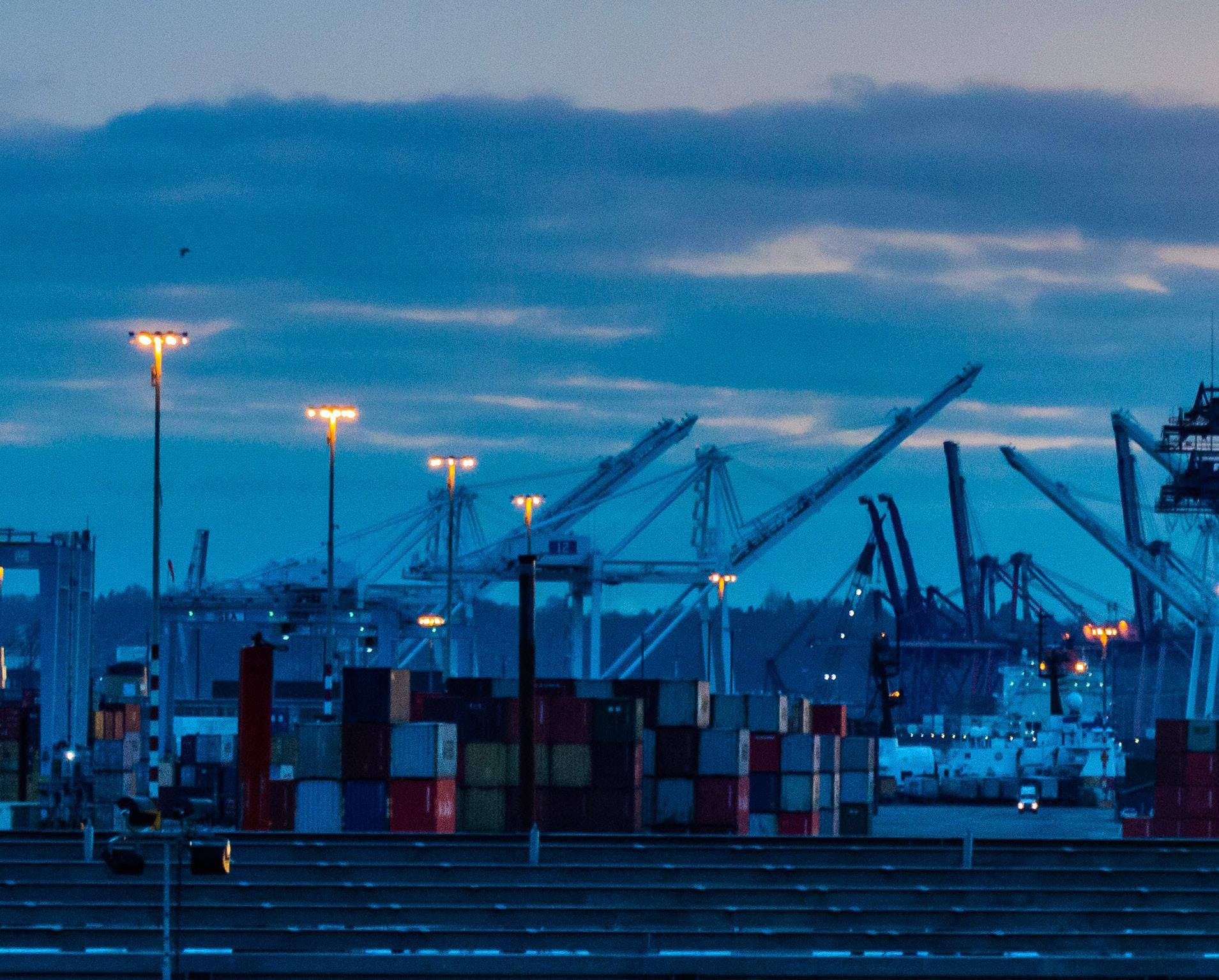
All our fleet vessels are designed with at least 50% lower than required EEDI and already comply with EEDI phase III emission reduction requirements.
Not impacted by EEXI implementation
Based on 2021 data our entire fleet was rated “A” or “B” in the IMO Rating Scheme and is expected to range at similar levels at least until 2026
of electricity consumed at Minerva Headquarters came from renewable energy sources.
Note: Refer ESG data tables at the end of the report for further details on Energy consumption, GHG emissions, EEDI, EEXI and CII

To limit the environmental impact of our waste streams, we ensure proper waste handling and management. To keep track of the waste handling and management activities onboard, we've put together detailed Management Plans (Garbage, Sludge & Bilge, Sewage, etc.) and have assigned dedicated deck and engine room Environmental Officers.
The oily waste on our vessels mainly comes from the daily operation of our engine rooms. Appropriate equipment has been installed to ensure proper handling of the waste generated, including incinerators, oily bilge water separators, and compactors. Whenever the waste cannot be treated on board, we will deliver them ashore to approved facilities for further treatment.
Regular monitoring to identify opportunities for reduction, improving garbage management and ensuring regulatory compliance.
Garbage management metrics are collected upon every vessel’s departure through the dedicated Garbage Handling Reports.
Wastes are compacted into small bundles and offloaded for further treatment.
Regular monitoring of plastic waste generated on board.
The company is working with suppliers to ensure minimal use of plastic in packaging materials.
Gradual replacement of single use plastics onboard.
Installing water dispensers on board the vessels to reduce the plastic water bottle consumption. We also use larger water containers instead of small water bottles to further reduce plastic waste onboard.
We have recycling bins on board and plastic material is segregated.
Agreements with recycling companies at major ports in USA, Rotterdam and Singapore.
As an organization operating in the maritime transportation industry, we are conscious of the importance of water conservation, and we promote its reasonable use both onboard our vessels and at our office premises.
Our vessels are encouraged to produce fresh water from the freshwater generator in order to minimize their impact on natural resources.
Discharge of untreated sewage poses significant risks for all aquatic ecosystems and can also cause detrimental impacts on human health. Minerva Gas vessels being assigned with environmental notations do not discharge any untreated sewage. Proper operation of Sewage Treatment Plants (STP) is ensured through a comprehensive maintenance plan, while discharges are being recorded.
All vessels are fitted with Ballast Water Treatment Systems (BWTS) suitably type approved by relevant authorities. We ensured that any water discharged into the sea is adequately treated to avoid any harm to the marine ecosystem.
We are active participants of the beach cleaning initiatives organized by HELMEPA. HELMEPA is a Non-Profit and Non-Governmental Organization,
with the mission to assist the wider maritime community to acquire a safety spirit and environmental consciousness.


7,463
tons of freshwater produced per vessel annually

588 0
m3 of water consumed in office buildings
untreated ballast discharges 2021


TABLE 1: SCOPE 1 EMISSIONS AND FUEL CONSUMPTION
TABLE 2: SCOPE 2 EMISSION

*Note: The garbage data provided for some of the fleet vessels is an annual estimate, as these vessels were under a different management previously



NUMBER OF SHIPBOARD EMPLOYEES
ABOUT MINERVA GAS TOTAL DISTANCE TRAVELED BY VESSELS
ESG DATA TABLESENVIRONMENT
NUMBER OF VESSELS IN TOTAL SHIPPING FLEET
NUMBER OF VESSEL PORT CALLS TR-MT-000.F
ABOUT MINERVA GAS
ESG DATA TABLESENVIRONMENT
GREENHOUSE GAS EMISSIONS
GROSS GLOBAL SCOPE 1 EMISSIONS
DISCUSSION OF LONG-TERM AND SHORTTERM STRATEGY OR PLAN TO MANAGE SCOPE 1 EMISSIONS, EMISSIONS REDUCTION TARGETS, AND AN ANALYSIS OF PERFORMANCE AGAINST THOSE TARGETS
(1) TOTAL ENERGY CONSUMED, (2) PERCENTAGE HEAVY FUEL OIL, (3) PERCENTAGE RENEWABLE
AVERAGE ENERGY EFFICIENCY DESIGN INDEX (EEDI) FOR NEW SHIPS
TR-MT-110A.1 158,316 MT CO2E
TR-MT-110A.2 /
TR-MT-110A.3
TR-MT-110A.4 4.568
AIR QUALITY
ECOLOGICAL IMPACTS
AIR EMISSIONS OF THE FOLLOWING POLLUTANTS: (1) NOX (EXCLUDING N2O), (2) SOX, (3) VOLATILE ORGANIC COMPOUNDS (VOCS), AND (4) PARTICULATE MATTER (PM10)
SHIPPING DURATION IN MARINE PROTECTED AREAS OR AREAS OF PROTECTED CONSERVATION STATUS
PERCENTAGE OF FLEET IMPLEMENTING BALLAST WATER (1) EXCHANGE AND (2) TREATMENT
(1) NUMBER AND (2) AGGREGATE VOLUME OF SPILLS AND RELEASES TO THE ENVIRONMENT
EMPLOYEE HEALTH & SAFETY LOST TIME INCIDENT RATE (LTIR)
TR-MT-120A.1
6.3 ENERGY AND EMISSIONS
6.3 ENERGY AND EMISSIONS
(1) 2,506,720 GJ (2) 0.04% (3) ~0% NA
ESG DATA TABLESENVIRONMENT
(1) NOX: N/A (2) SO2: 64.5 METRIC TONNE
(3) VOCS: N/A
(4) PARTICULATE MATTER: 19.5 METRIC TONNE
ESG DATA TABLESENVIRONMENT
TR-MT-160A.1 NOT AVAILABLE NOT AVAILABLE
TR-MT-160A.2 100%
6.5 WATER CONSERVATION AND PROTECTING MARINE ECOSYSTEM
TR-MT-160A.3 0
6.5 WATER CONSERVATION AND PROTECTING MARINE ECOSYSTEM
HEALTH & SAFETY
BUSINESS ETHICS
NUMBER OF CALLS AT PORTS IN COUNTRIES THAT HAVE THE 20 LOWEST RANKINGS IN TRANSPARENCY INTERNATIONAL’S CORRUPTION PERCEPTION INDEX TR-MT-510A.1 0 /
TOTAL AMOUNT OF MONETARY LOSSES AS A RESULT OF LEGAL PROCEEDINGS ASSOCIATED WITH BRIBERY OR CORRUPTION TR-MT-510A.2 0 /
NUMBER OF MARINE CASUALTIES, PERCENTAGE CLASSIFIED AS VERY SERIOUS TR-MT-540A.1 0 /
ACCIDENT & SAFETY MANAGEMENT
NUMBER OF CONDITIONS OF CLASS OR RECOMMENDATIONS TR-MT-540A.2 0 /
NUMBER OF PORT STATE CONTROL (1) DEFICIENCIES AND (2) DETENTIONS

0 /
ABBREVIATION
AER
BWTS
CBT
CII
ECDIS
EE
EEDI
EEMS
EEXI
EPMD
ESG
ESI
FY
GRB
HELMPA
HFO
HR
HSQ
HSQE ICT
IHM
ILO
IMO ISM ISO LNG
LSMGO LTIR
MARPOL MD MGMS
MLC MRM NGO NOx
ORB
PDCA PPE
SIGTTO SMS
STPs
SWOT
VLSFO
VSR
Annual Efficiency Ratio
Ballast Water Treatment Systems
Computer-based Training
Carbon Intensity Indicator
Electronic Chart Display and Information System
Energy and Environment
Energy Efficiency Design Index
Energy and Environment Management System
Efficiency Existing Ship Index
Environmental Performance and Monitoring Database
Environmental, Social, and Governance
Environmental Ship Index
Financial Year
Garbage Record Book
Hellenic Marine Environment Protection Association
Heavy Fuel Oil
Human Resources
Health, Safety, and Quality
Health, Safety, Quality and Environment
Information and Communications Technology
Inventory of Hazardous Material
International Labour Organization
International Maritime Organization
International Safety Management
International Organization for Standardization
Liquefied Natural Gas
Low Sulphur Marine Gas Oil
Lost-time Incident Rate
The International Convention for the Prevention of Pollution from Ships
Material Declaration
Minerva Gas Management System
Maritime Labour Convention
Management Review Meeting
Non-governmental organization
Nitrogen Oxides
Oil Record Book
Plan – Do – Check – Act
Personal Protective Equipment
The Society of International Gas Tanker and Terminal Operators
Safety Management System
Sewage Treatment Plants
Strengths, Weaknesses, Opportunities & Threats
Very Low Sulphur Fuel Oil
Voluntary Vessel Speed Reduction
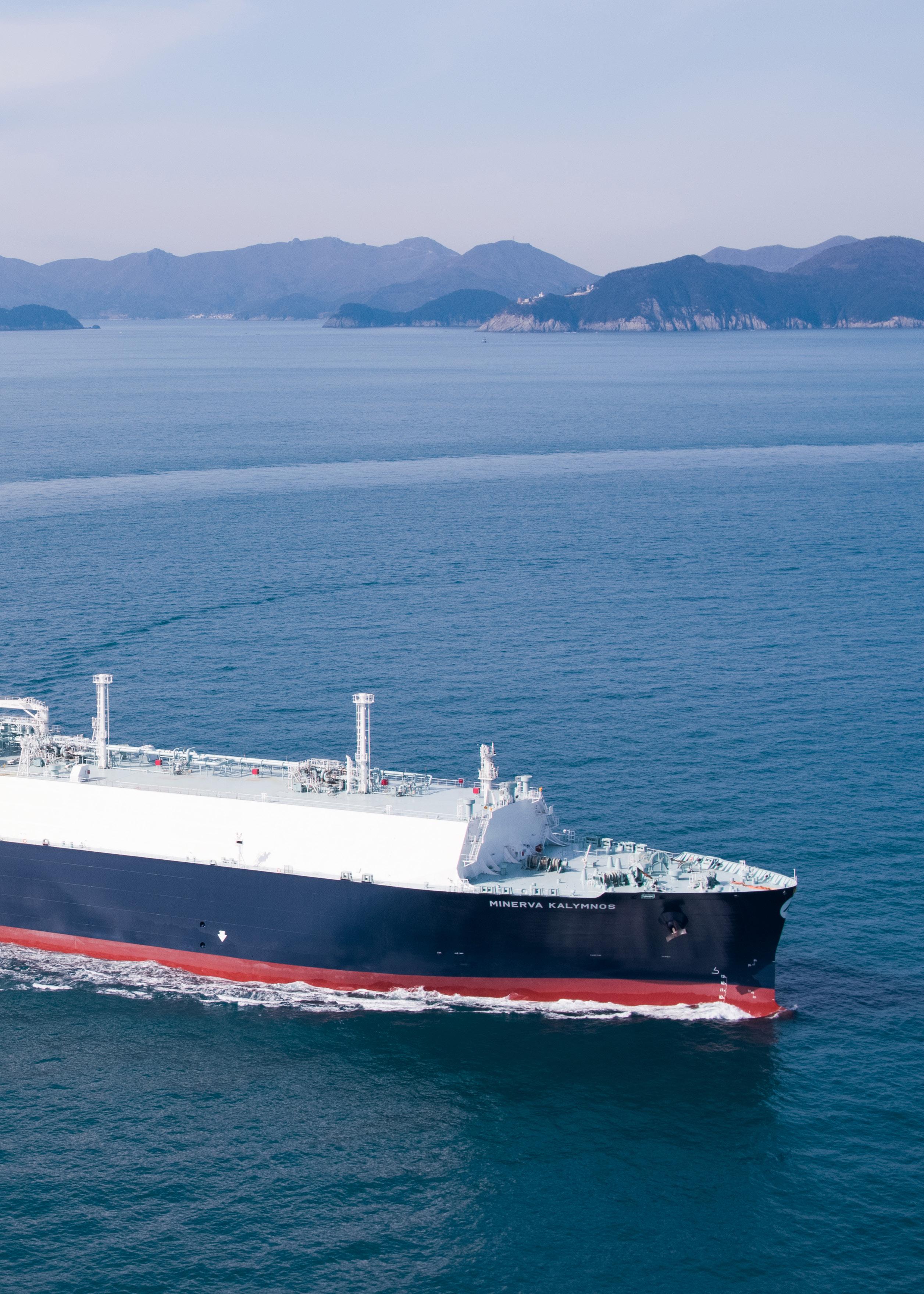
Includes fuel consumed on fleet vessels (including HFO, VLSFO, LSMGO and LNG) and electricity consumed in office building.
Since all Minerva companies (MARINE, DRY and GAS) are located in the same office building, the provided electricity consumption and water consumption in office building is given proportionally to the number of Minerva Gas employees.
PERCENTAGE RENEWABLE ENERGY
An assumption is made that the part of energy that derives from renewable energy sources is proportional to the amount of energy produced by our electricity provider from renewable sources.
The Garbage data provided is an estimate for the entire year based on the data available for specific months in which the vessels were under our management.
GHG emissions are calculated via default conversion factors for fuel consumption and grid emission conversion factors for electricity consumption. The grid emission factor for electricity consumption is sourced from the Association of Issuing Bodies (AIB). Based on the guidance provided through the recently published FuelEU Regulation the equivalent CO2 emissions of CH4 and NO2 were also calculated and added in total emissions.


